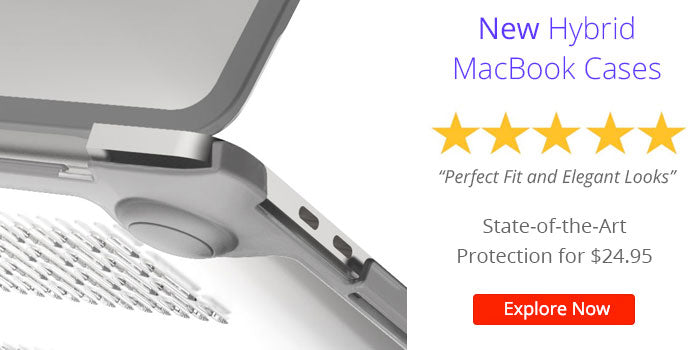Are Hardshell Cases Bad for MacBooks Air?
MacBook Air users know the fine line they tread between the sheer delight of wielding a sleek and powerful machine and the perpetual concern for its safety. Enter hardshell MacBook Air cases—a seemingly straightforward solution to the quest for protection.
They shield against scratches and dings, but older designs can trap heat and potentially scratch the aluminum body. These older or poorly designed models can impede airflow, causing overheating, especially on newer fanless Airs.
it doesn't matter if you have a MacBook Air 13-inch case or a MacBook Air 15-inch case, an older, single-material cases of this type can present some potential problems compared to the current generation of co-molded MacBook covers.
So the story isn't as simple as it appears, especially when we delve into the evolution of these MacBook hardshell cases.
Are Single-Material MacBook Air Hardshell Cases Bad?
In the not-so-distant past, MacBook Air hardshell cases predominantly hailed from the era of single-material designs, often composed of polycarbonate. While these cases offered a semblance of protection, they brought along a host of issues that left users grappling with the unintended consequences.
The rigid nature of single-material polycarbonate MacBook Air hardshell cases meant that contact points—where the case met surfaces—were prone to abrasion. The constant friction against tables, bags, and other surfaces led to visible wear and tear, marring the very MacBook Air these cases were meant to protect.
This was a huge problem not only because the damage was being caused by the very thing you bought to provide protection, but a marred laptop finish would hurt the ability to secure a top price come resale or upgrade time.
MacBook Airs are engineered for their slim and lightweight design, and any addition to this equilibrium needs to be considerate of thermal dynamics. Unfortunately, the older hardshell designs were often deficient in proper heat dissipation, contributing to concerns of overheating during prolonged use.
Are Hardshell Cases Bad for MacBook Air Screens?
The quest for slimness means that your MacBook Air hinges on precision, quite literally. Single-material Mac Air hard shell cases, with their sometimes inflexible structure and weight, exerted pressure on the MacBook's hinges. Over time, this led to premature wearing and eventual issues with the smooth operation of the screen.
The very Mac Air hard shell case meant to protect your Air became an inadvertent repository for dirt and dust. The space between your laptop and the Mac Air hard shell case became a breeding ground for particles that, over time, turned into abrasive agents, causing scratches on the device's surface.
This can lead to a sense of betrayal. You paid good money for a product you thought was going to protect and it winds up hurting the very laptop you wanted to keep safe. Is there a better solution?
What Are the Best MacBook Air Hardshell Cases?
Acknowledging the limitations of the old guard, enter the era of co-molded Mac Air hard shell cases—a technological leap that redefines Apple portable protection.
We asked MacCase founder and Chief Creative Officer Michael Santoro about the advantages of these new hybrid designs. Michael has been designing cases to protect Apple portables for over 25 years.
"The co-molded technology is a game changer for these types of cases. Our co-molded Mac Air hard shell cases leverage the synergy of polycarbonate and TPU (Thermoplastic Polyurethane). This strategic combination ensures that the case is rigid where needed for protection and flexible where necessary for a snug fit and ease of installation."
"The co-molding process facilitates a nuanced distribution of impact forces. This translates into enhanced shock absorption capabilities, meaning that minor bumps and drops are absorbed by the case, sparing your MacBook Air from potential damage."
"Addressing the overheating concerns, our co-molded designs incorporate thoughtful ventilation and heat dissipation mechanisms. This ensures that your MacBook Air remains cool even during resource-intensive tasks, mitigating the risk of overheating."
"We're extremely proud of how these designs improve the overall user experience."
Rather than being a one-size-fits-all solution, co-molded Mac Air hard shell cases are often custom-tailored for specific MacBook Air models. This precision fit ensures that the case doesn't contribute to hinge wear and that there's no unnecessary friction at contact points.
The co-molding process seals the edges of the case with the softer TPU material, minimizing the ingress of dirt and dust. This prevents the abrasive action that plagued older designs, preserving the aesthetics of your MacBook Air.
The Recommended Choice for a Mac Air Hard Shell Case
In the grand narrative of MacBook Air protection, the co-molded, "hybrid" Mac Air hard shell cases emerge as the recommended choice, marking a pivotal evolution from the challenges posed by single-material designs.
Whether you're a professional navigating daily commutes or a creative mind seeking seamless protection, the co-molded Mac Air shell case aligns with the demands of modern Air usage.
It's a testament to the industry's commitment to continuous improvement, ensuring that your MacBook Air not only thrives in performance but does so enveloped in armor that complements its elegance.
In the ever-evolving landscape of technology, a co-molded Mac Air shell case stands as a beacon, debunking the notion that protection comes at the cost of elegance. It's a declaration that MacBook Air users can have the best of both worlds—style and robust protection, encapsulated in a case designed for the demands of today and the innovations of tomorrow.
Here are additional articles in this series you may find of interest:
Is a MacBook Hardshell Case Worth it?
Are MacBook Pro and MacBook Air Cases the Same?





